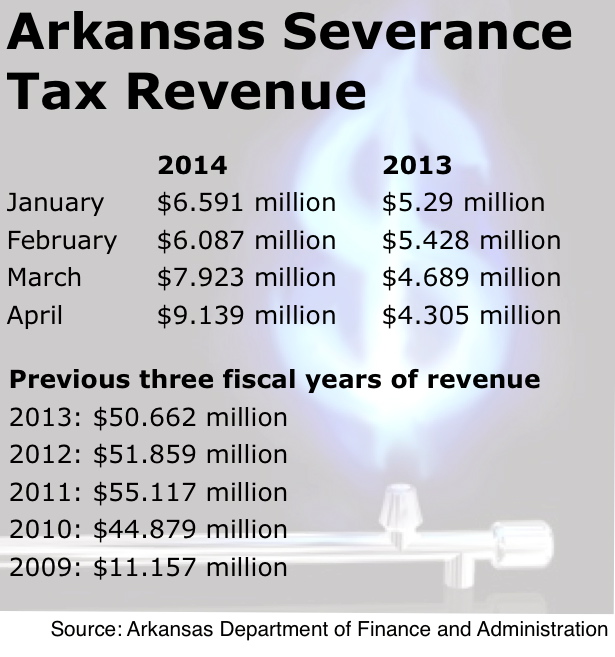Quarterly, Monthly Arkansas Severance Tax Collections Hit New Highs
by May 21, 2014 2:32 pm 87 views
Quarterly and monthly severance tax collections in 2014 set new record highs as Arkansas continues to reap the benefits from higher natural gas prices and steady production levels primarily in the Fayetteville Shale, state revenue statistics show.
For the first three months of 2014, gross natural gas severance tax revenue came in at $19.9 million, up 29% from $15.4 million in the same period of 2013. At the same time, monthly collections of $7.3 million and $9.1 million in March and April, respectively, were the highest severance tax revenue totals posted since the state began keeping such records.
Overall, severance tax collections for January, February, March and April all came in well above $6 million, also a first for the state of Arkansas. The fiscal year for the state of Arkansas begins on July 1, 2013 and ends on June 30, 2014. In fiscal 2013, the highest monthly severance tax collection was $5.8 million in June.
The severance tax data is compiled by the Revenue Division of the Arkansas Department of Finance & Administration using monthly tax reports filed by producers. According to Tom Atchley, DF&A’s excise tax administrator, current severance tax amounts reported by the state’s Revenue Office are based on the “revenue month, not the report month.” For example, tax payments received in April may not be due until May.
Still, severance tax revenue has steadily increased each year since the Legislature raised the levy on natural gas production in 2009.
Kathy Deck, director and economist at the Center for Business and Economic Research at the University of Arkansas, said the bullish record tax collections are driven by the same factors that have affected severance tax collection swings in the past.
“Unless a law is changed, higher severance tax revenues come from only two things — higher (natural gas) prices and higher production levels,” Deck said. “The 1Q collections are a combination of both.”
Deck added that because tax collections are a function of production and prices, it still isn’t clear whether Arkansas will see revenues fall off even as production declines, a trend several Wall Street analysts have predicted.
“It depends on the state of the overall market,” Deck cautioned.
For example, Arkansas severance tax collections have increased, even as natural gas producers like Southwestern Energy and Chesapeake have shifted their drilling rigs to liquids-rich shale developments like the Marcellus basin in Pennsylvania and the Haynesville play in Louisiana.
If the trend continues through the end of the fiscal year, severance tax collections in Arkansas could “conservatively” reach $80 million for the tax period ending June 30, 2014. That is a 30% improvement over fiscal year 2013, noted J. Kelly Robbins, executive vice president of the Arkansas Independent Productions and Royalty Owners (AIPRO).
“That is wonderful news for the state Arkansas,” Robbins said. “Those funds are earmarked for state highways and city and country roads. It shows that the Arkansas severance is going to be around for a long time helping to improve roads for the people of Arkansas.”
Robbins also said even with the declining rig count in Arkansas, natural gas production levels in the Fayetteville Shale, the Arkoma basin and South Arkansas have increased because of improved drilling technology and better knowledge on how to maximize well production.
“Despite the rig count, producers have more knowledge and wisdom on how to get the most out of these geological formations in Arkansas,” Robbins said.
According to Baker Hughes, natural gas rig counts in the U.S. remained flat week-over-week at 326 – slight up from 323 rigs in operation a week ago. In Arkansas, the number of rotary rigs operating in Arkansas as of May 16 held steady at 12, the same as a week ago.
Meanwhile, Southwestern Energy reported earlier this month that it had placed 105 new wells on production in the Fayetteville Shale, resulting in net gas production from the Fayetteville Shale of 119.4 billion cubic feet (Bcf) in the first quarter of 2014, compared to 118.9 Bcf in the first quarter of 2013.
Of that total, the company placed 30 operated wells on production with initial production rates that exceeded 5,000 million cubic feet (Mcf) per day, and 18 wells that exceeded 6,000 Mcf per day. Gross operated gas production in the Fayetteville Shale was nearly 2,022 MMcf per day at the end of the first quarter.
Robbins said Southwestern and other shale producers are averaging about five business days to get their drilling operations up and running. “What use to take 15 to 30 days, now takes five days, which helps the (bottom line),” he said.
Still, Robbins said, the most important factor in the natural gas marketplace is a stable commodity price. Just two years, natural gas producers were considering whether to mothball their drilling operations as glutted production and a mild winter pushed spot prices to their lowest level in more than a decade. On Feb. 6, 2012, the benchmark natural gas prices for delivery at Henry Hub, La., closed at $2.42 per million British thermal units (MMBtu).
Today, natural gas prices throughout 2014 are up significantly from last year, with first quarter prices averaging $4.72 per MMBtu compared to the 2013 average price of $3.73 per MMBtu at Henry Hub, according to the U.S. Energy Information Administration (EIA).
In trading Wednesday, NYMEX natural gas futures were trading at $4.547 per MMBtu. Prices have trended up 4.5% in the past week, finishing Tuesday at their highest point since May 8.

